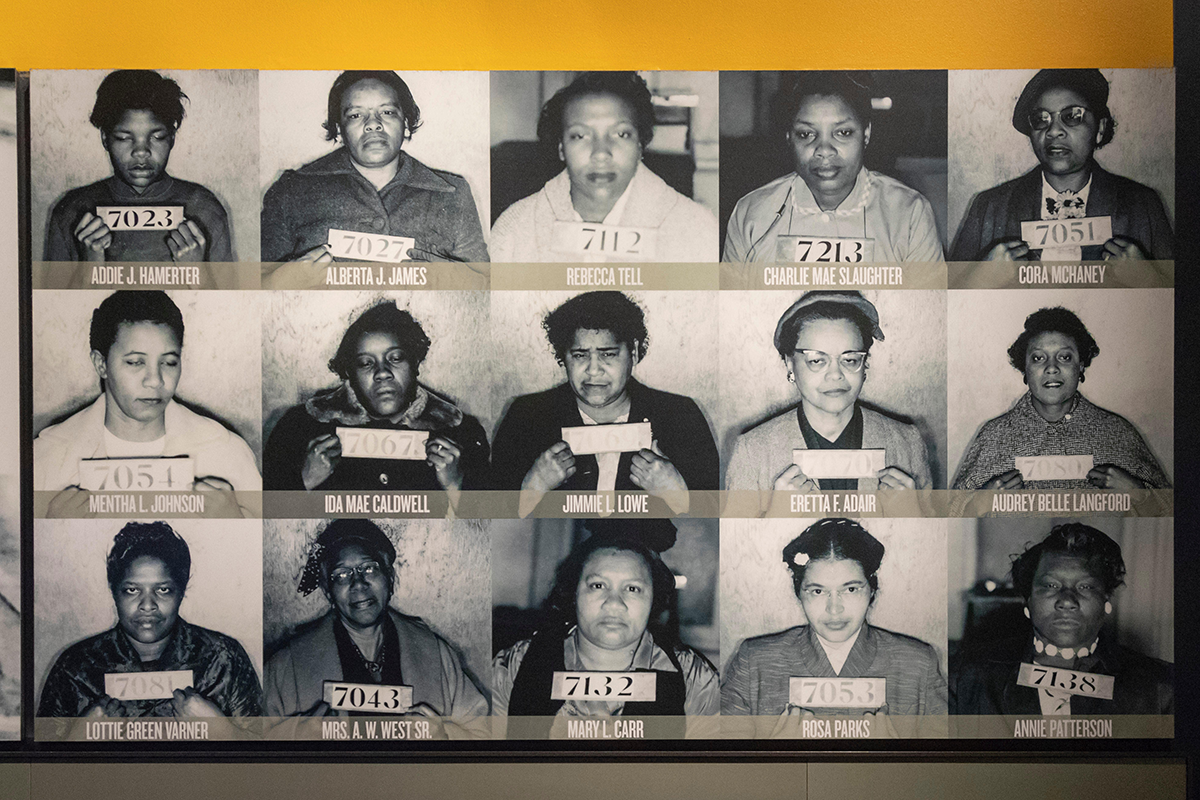Montgomery Bus Boycott: Organizing Strategies and Challenges
Lesson by Alana D. Murray
Mug shots of women who were arrested for violating an anti-boycott law during the 1955-56 Montgomery Bus Boycott from a display at the National Civil Rights Museum at the Lorraine Motel. © Jim West / Alamy
The Montgomery Bus Boycott is a model for social movement organization and strategy because it had all the ingredients for success, including:
drawing from preexisting social organizations and establishing a support base through the development of networks;
having a catalytic leadership, who had the power to stimulate and encourage followers, and the ability to determine when and how to respond to events and circumstances;
tapping outside resources in the immediate locale and developing and cultivating interest among those who may be or appear to be uninterested;
employing a strategy rooted in confronting oppression, providing hope, challenging existing structures, and achieving relief from injustice; and
defining a clear, ultimate goal of eliminating segregation.
(This list is drawn from a course presentation by Julian Bond.)
Most textbooks and children’s books about the boycott emphasize the second ingredient — the catalytic leadership of Martin Luther King Jr. and Rosa Parks — leaving out not only the other critical elements, but, most importantly, the role of the thousands of Montgomery residents who boycotted public transportation for over a year.
In this activity, students act as organizers and learn about many of the challenges faced by a group who sustained a bus boycott in Montgomery, Alabama, for 381 days. The activity typically takes five to seven class periods. While it is designed for middle school students, high school teachers can successfully modify this lesson for the upper grades by making the decision-making process less structured.
Find a video of a related activity for early elementary grades by Maggie Donovan, “Teaching About the Montgomery Bus Boycott,” on the Teaching for Change YouTube page.
Grade Level: Middle school+
Time Required: Five class periods
Objectives
Identify the factors that contributed to the success of the Montgomery Bus Boycott in promoting social change by engaging in collaborative problem-solving, decision-making, and consensus-building activities.
Employ listening and note-taking strategies when reading about the Civil Rights Movement.
Examine the role of ordinary people in challenging segregation and advancing democracy and present findings clearly through a written report.
Analyze historical documents to gain an understanding of how resistance strategies, such as collective action, civil disobedience, and campaign organizing, can impact unequal policies.
Readings for Teachers
At a minimum, teachers should read “The Politics of Children’s Literature: What’s Wrong with the Rosa Parks Myth” by Herbert Kohl (in the Critiquing the Traditional Narrative section of Putting the Movement Back into Civil Rights Teaching).
If possible, teachers should also read Daybreak of Freedom: The Montgomery Bus Boycott (University of North Carolina Press, 1997) and/or The Montgomery Bus Boycott and the Women Who Started It: The Memoir of Jo Ann Gibson Robinson (University of Tennessee Press, 1987).
The section on the bus boycott in Voices of Freedom: An Oral History of the Civil Rights Movement from the 1950s through the 1980s (Bantam Books, 1990) tells a powerful story through first-person testimonies. This book can bring to life the experiences it describes for both middle and high school students.
© 2024 Alana D. Murray
Sample Handout
Rustin to King: Memo on the Montgomery Bus Boycott, Dec. 23, 1956 (from Daybreak of Freedom: The Montgomery Bus Boycott, p. 329)
Directions: Read the memo below by Bayard Rustin about the success of the Montgomery Bus Boycott. Then list at least six of the reasons that he gives to explain why it worked. Based on your experience with and analysis of the boycott, place a check next to the two reasons that you think are most important, and/or add another reason of your own.
Montgomery possessed three features that are not found in other movements or efforts:
1. It was organized; used existing institutions as foundations so that all social strata of the community were involved. It thus has the strength of unity, which the school integration efforts have lacked, thereby leaving the fight to heroic but isolated individuals. Montgomery could plan tactics, seek advice and support, develop financial resources and encompass a whole community in a crusade dominating all other issues. The reason there were those who did not want to give up the boycott is due in part to the consciousness that this welding of a comprehensive, unified group has a quality not to be lost. The fellowship, the ideals, the joy of sacrifice for others and other varied features of the movement have given people something to belong to which had the inspiring power of the Minute Men, the Sons of Liberty, and other organized forms which were products of an earlier American era of fundamental change.
2. The actions of the people won the respect of their enemy. The achievement of unity, the intelligence of planning, the creation of a competent complex system of transportation, the high level of moral and ethical motivation, all combined to give the closed mind of the white Southerner an airing that it has never had. It is not only the Negroes’ self-respect which has won — but the respect of white people, who, though they retain a basic prejudice, have lost something in the course of this year that begins their long struggle to genuine understanding. In short, Montgomery has contributed to the mental health and growth of the white man’s mind, and thus to the entire nation.
3. Montgomery was unique in that it relied upon the active participation of people who had a daily task of action and dedication. The movement did not rely exclusively on a handful of leaders to carry through such fundamental change.

